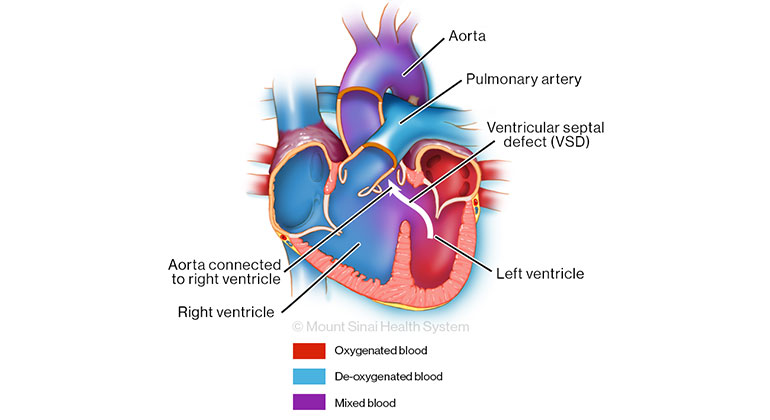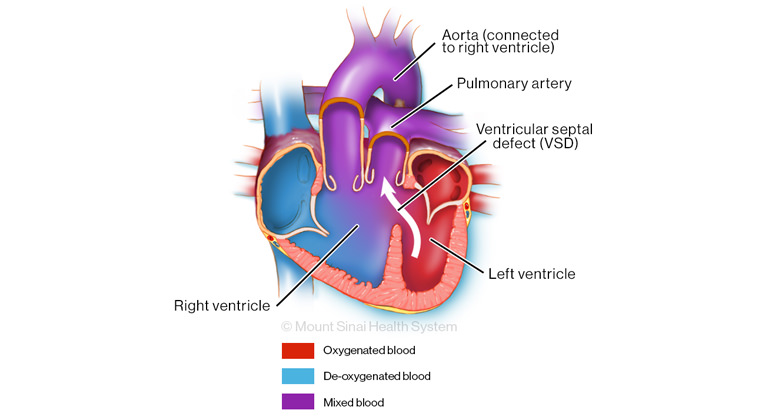Double Outlet Right Ventricle
If your child has a diagnosis of double outlet right ventricle (DORV), you will want to know as much as possible about the problem—and the solution. And you want to know as quickly as possible.
Mount Sinai Kravis Children’s Heart Center provides expert advice to you and the best care for your child. Our doctors are highly trained and experienced in addressing all heart problems, including DORV.
About Double Outlet Right Ventricle (DORV)

DORV with subaortic VSD
Normally, the aorta, which supplies the body with blood, comes from the left-pumping chamber of the heart (ventricle). And the pulmonary artery, which supplies the lungs, comes from the right ventricle. In DORV, however, both arteries that carry blood from the heart to the body and the lungs come from just the right ventricle. In DORV, the heart also has a hole between the two ventricles, a condition called a ventricular septal defect(VSD), forcing blood from the left ventricle to move across the VSD to reach the arteries.

DORV with subpulmonary VSD
There are many variations of DORV. Your child’s symptoms and treatment will depend on how the position of the arteries along with the VSD and other possible abnormalities.
Symptoms
Your child’s DORV symptoms depend on the specific anatomy of the heart and may include:
- Blue-or purple-tinted lips, skin, and nails from low oxygen levels (cyanosis)
- Heart murmur
- Difficult feeding
- Poor weight gain
- Rapid or shallow breathing
- Sweating, especially when eating
Diagnosis
Our Fetal Heart Program specialists can diagnose double outlet right ventricle before your baby is born. When we detect the condition during pregnancy, our doctors will monitor mother and baby throughout the pregnancy. Your dedicated team of specialists will explain how we can help you and will develop a plan for your baby’s birth and afterward.
In other cases, we find the DORV after birth. We may perform certain diagnostic tests in your child to confirm the presence of DORV so we can plan treatment. Diagnosis may include:
- Chest X-ray, which takes pictures of the your child’s heart, lungs, and blood vessels, and can show if the heart is enlarged
- Cardiac magnetic resonance imaging (MRI), which uses safe, powerful magnets and radio waves to create pictures of your child’s heart
- Echocardiogram (echo or ultrasound), which uses sound waves to create pictures of the heart chambers, valves, walls, and blood vessels a safe, noninvasive procedure that uses ultrasound waves to create an image of the size, shape, and movement of your child’s heart, valves, and chambers along with how blood flows (also called an echo or cardiac ultrasound)
- Electrocardiogram (EKG or ECG), which is a noninvasive procedure that shows electrical activity by placing stickers on your child’s chest
We may need to perform a cardiac catheterization, a test that involves inserting a thin tube into the baby’s blood vessels, usually in the groin to reach the heart. This test allows us to measure blood pressure and oxygen levels and get detailed pictures of the heart and vessels.
Treatments We Offer
To treat DORV, we may need to surgically close the ventricular septal defect (VSD) and correct blood flow—from the left ventricle into the aorta and from the right ventricle into the pulmonary artery. The approach your child’s surgeon uses depends on the specific anatomy of your child’s DORV.
- For DORV with aorta closer to the left ventricle and pulmonary artery further away:
- The surgeon closes the VSD to direct blood from the left ventricle to the aorta. If the pulmonary valve and artery are narrow, we can enlarge them.
- For DORV with aorta further away from left ventricle and pulmonary artery closer:
- The surgeon performs an arterial switch operation to switch the placement the pulmonary artery and aorta. The surgeon also closes the VSD to direct blood from the left ventricle into the new aorta, which is now closer to the left ventricle.
Other variations of DORV may require different treatment strategies and surgeries. The size and location of the VSD can vary and sometimes there is a narrowing or blockages as well as heart abnormalities. The treatment plan will address your child’s overall needs. The cardiology team will review with you in detail your child’s specific anatomy, and how we will provide personalized care. Patients with DORV require lifelong follow-up care, and the Children’s Heart Center is here for your child.
Why Choose Children’s Heart Center?
Mount Sinai’s pediatric cardiologists use an integrated team approach and provide compassionate care to all our patients and support to their families. We are expertly trained and highly experienced with all manner of heart conditions.
We get to know you and your child and involve our integrated team of specialists in developing the right treatment plan for your child. At the Children’s Heart Center, your child is at the center of all we do.